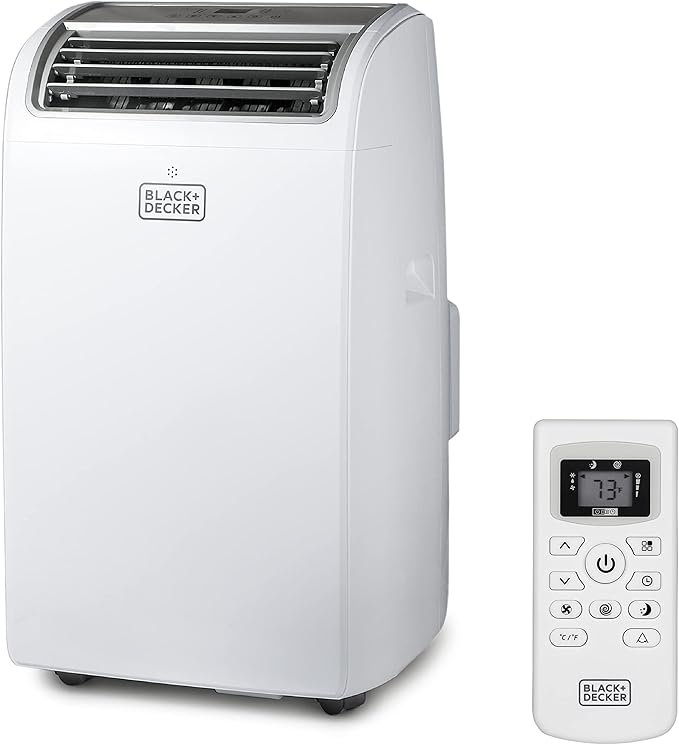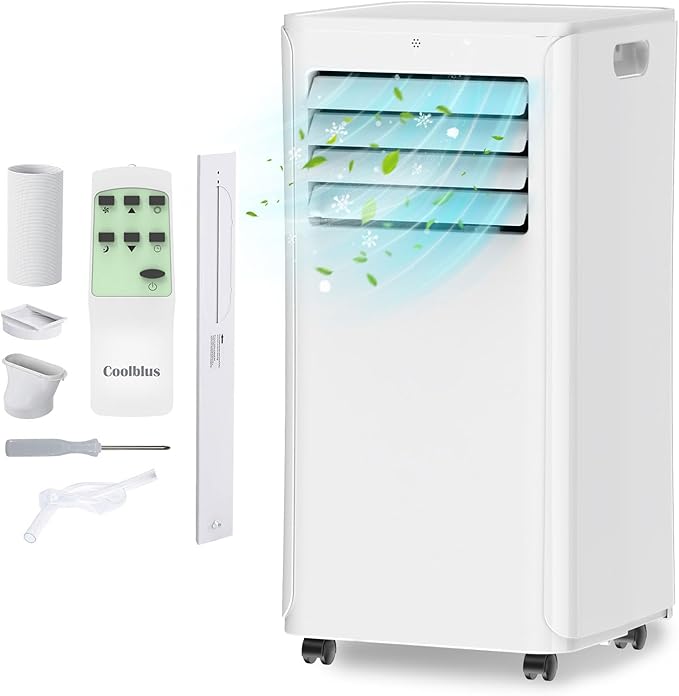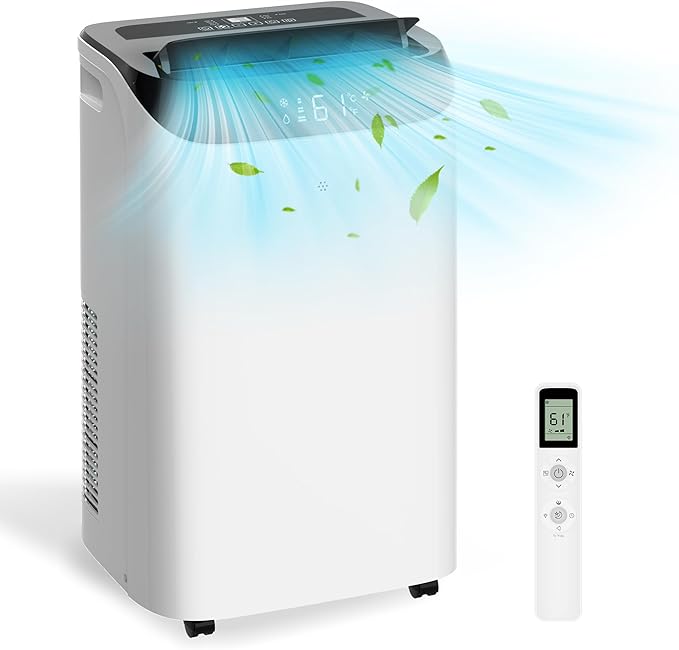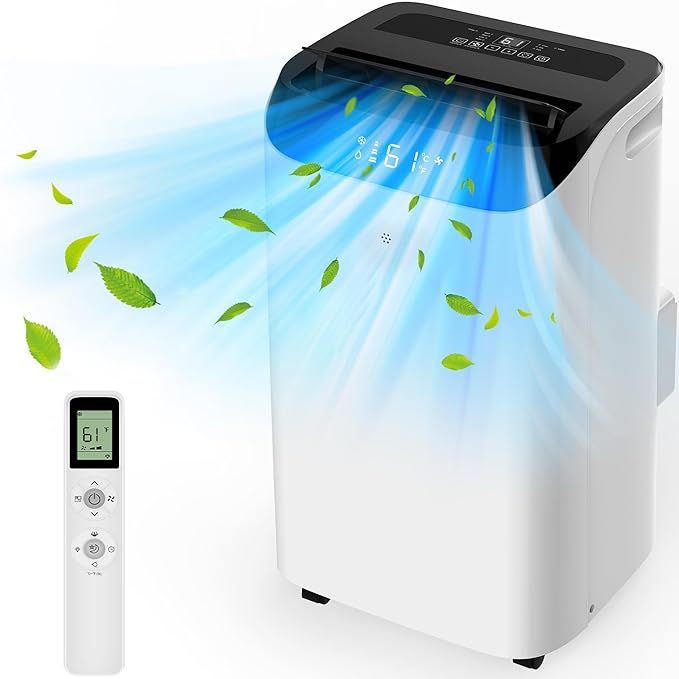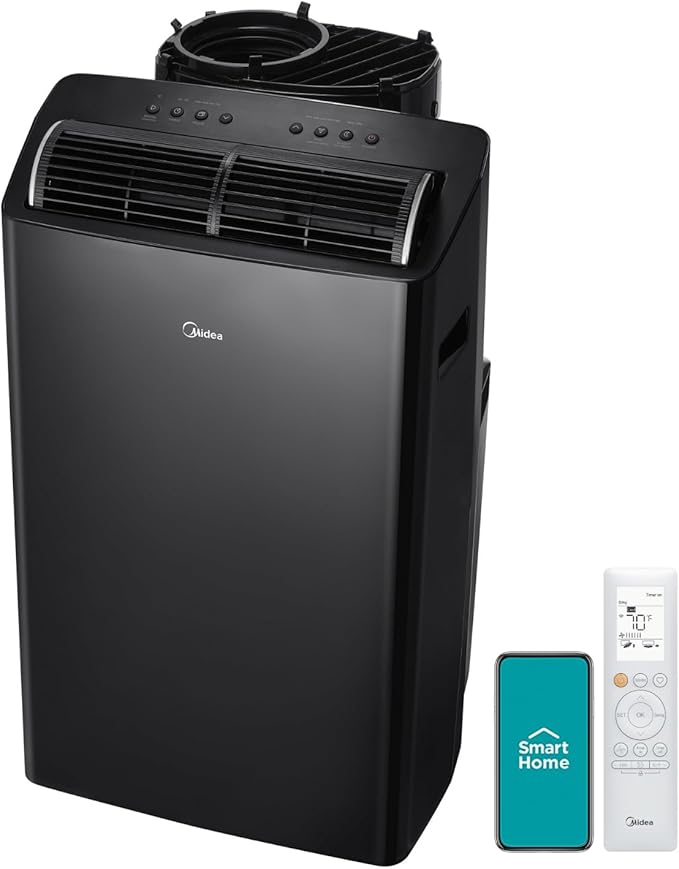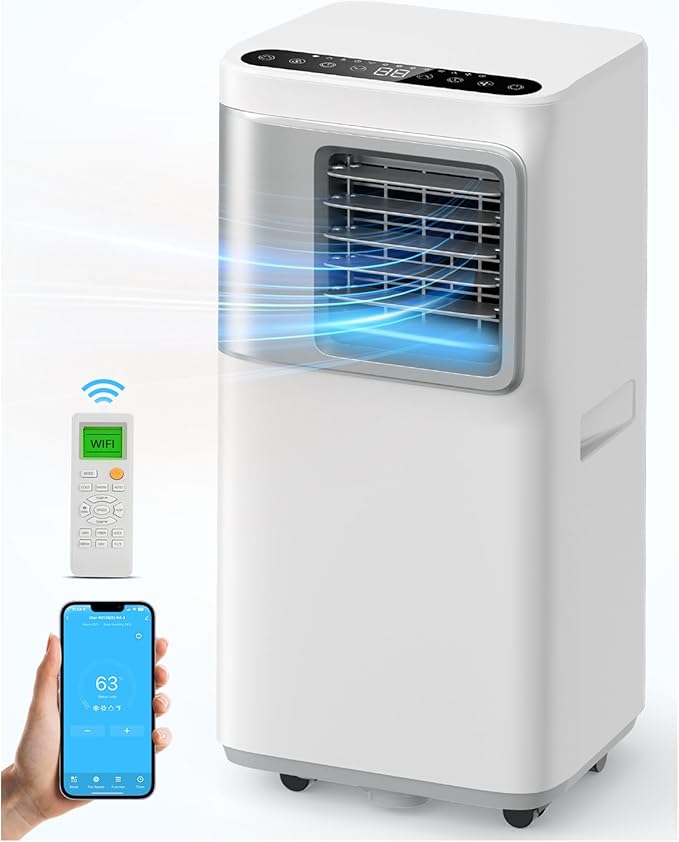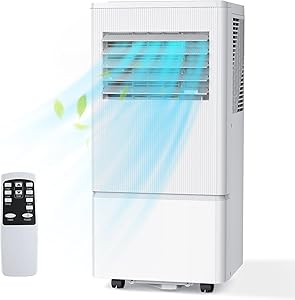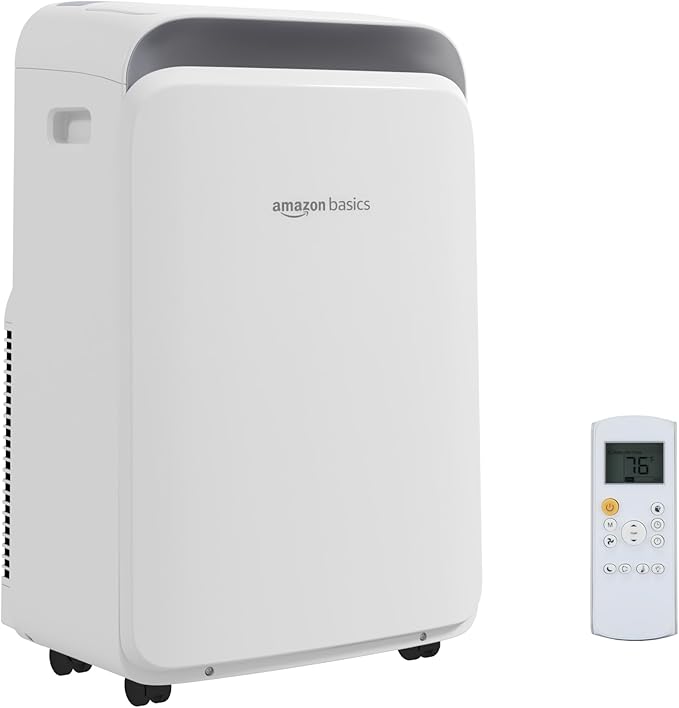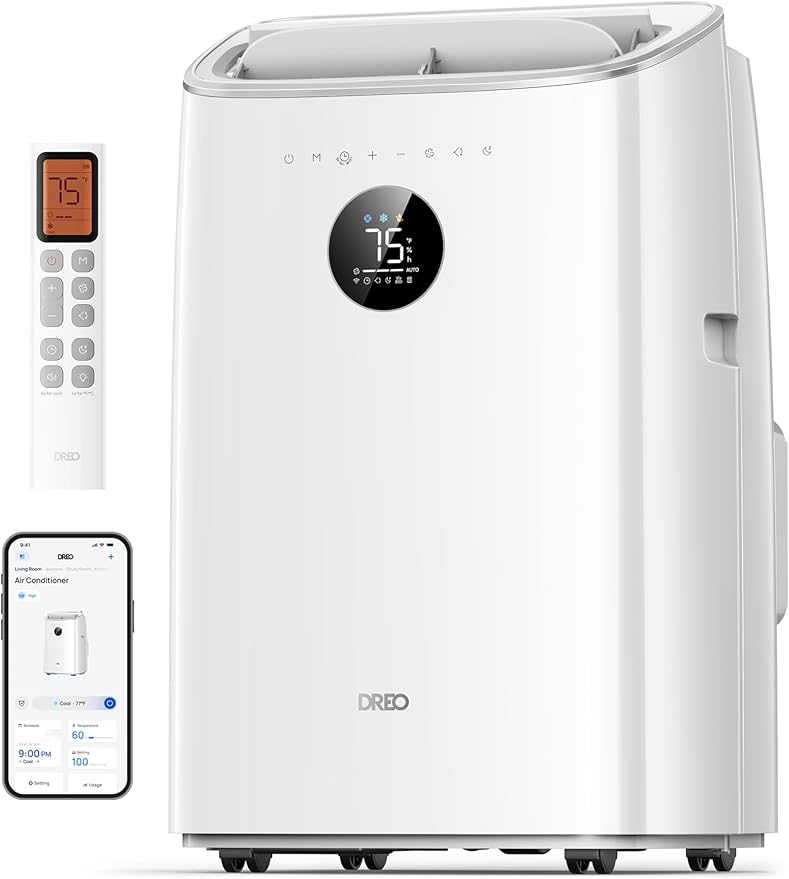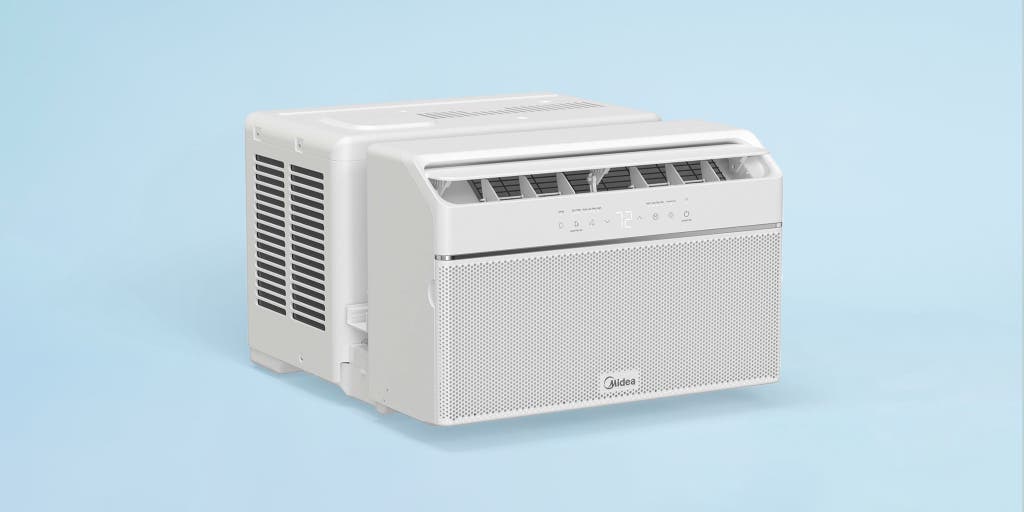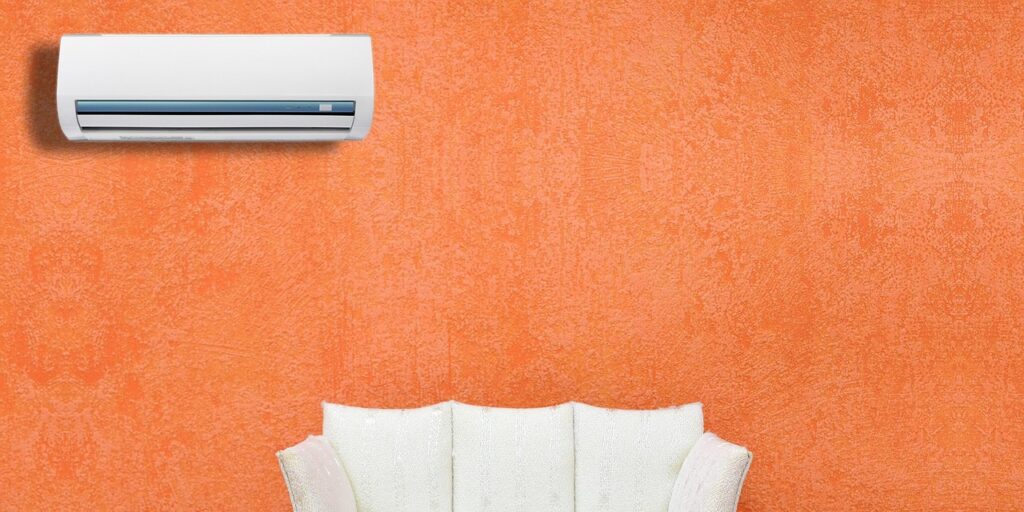We independently review everything we recommend. We may make money from the links on our site.
The Best Portable Air Conditioners

Finding the perfect portable air conditioner can transform your living space from uncomfortably warm to refreshingly cool, but navigating the crowded marketplace requires careful consideration. Whether you’re dealing with a scorching summer in an apartment without central air or need supplemental cooling for specific rooms, choosing the right portable AC unit makes all the difference in your comfort and energy bills.
The portable air conditioning market has evolved significantly, with manufacturers now offering more efficient, quieter, and feature-rich models than ever before. Modern units incorporate smart technology, improved energy efficiency ratings, and better cooling performance while maintaining the convenience that makes portable ACs so appealing.
Everything We Recommend
Smart Mobile Cooling
The Best Smart Mobile Cooling
This 12,000 BTU unit demonstrates exceptional performance in spaces up to 550 square feet, maintaining consistent temperatures through advanced sensor technology that monitors room conditions continuously.
Buying Options
Budget Cooling Option
The Best Budget Cooling Option
The Coolblus 12000 BTU unit delivers reliable cooling performance at an accessible price point, proving that effective climate control does not require premium investment. This model provides consistent temperature management for rooms up to 550 square feet while maintaining operational costs that align with budget-conscious cooling strategies.
Buying Options
High-Power Versatility
The Best High-Power Versatility
The DOMANKI 14,000 BTU unit addresses demanding cooling applications that exceed the capabilities of standard portable air conditioners. This high-capacity model effectively cools spaces up to 700 square feet while providing operational flexibility that adapts to changing room configurations and usage patterns.
Buying Options
Large Room Choice
The Best Large Room Choice
The HUMHOLD 14000 BTU model specializes in large room cooling applications where space dimensions and architectural features create significant cooling challenges. This unit effectively manages temperatures in areas up to 700 square feet, including rooms with high ceilings, multiple exposures, or architectural complexities that compromise cooling efficiency.
Buying Options
Ultra Quiet Inverter
The Best Ultra Quiet Inverter
The Midea Duo inverter model revolutionizes portable air conditioning through advanced compressor technology that eliminates the operational noise and efficiency limitations of conventional units.
Buying Options
Powerful Room Cooling
The Best Powerful Room Cooling
The BLATACY 16,000 BTU unit delivers maximum cooling capacity for extreme applications where standard portable air conditioners prove inadequate. This high-performance model manages temperatures in challenging environments up to 730 square feet, including spaces with significant heat generation or demanding cooling requirements.
Buying Options
Compact Room Comfort
The Best Compact Room Comfort
This unit delivers effective temperature management for areas up to 450 square feet while maintaining a minimal footprint that integrates seamlessly with contemporary interior designs.
Buying Options
Affordable Portable Option
The Best Affordable Portable Option
The Amazon Basics 10000 BTU unit focuses on essential cooling functionality while maintaining an accessible price point that makes portable air conditioning available to budget-conscious consumers.
Buying Options
Quiet Small Space
The Best Quiet Small Space
The Dreo 8,000 BTU model specializes in quiet, efficient cooling for small spaces where noise control and energy efficiency take precedence over maximum cooling capacity. This compact unit provides adequate temperature management for areas up to 350 square feet while maintaining whisper-quiet operation that preserves peaceful indoor environments.
Buying Options
How Portable Air Conditioners Work and Why They Matter
Portable air conditioners operate using the same basic refrigeration cycle as window units and central air systems, but they’re designed for maximum flexibility and ease of installation. These units draw warm air from your room, cool it using refrigerant coils, and then circulate the cooled air back into your space while venting hot air outside through a window kit.
The key advantage lies in their mobility and minimal installation requirements. Unlike window units that require specific window types and sizes, or central air systems that need extensive ductwork, portable ACs can be moved from room to room and typically require only access to a window for the exhaust hose.
According to the U.S. Department of Energy, portable air conditioners have become increasingly popular among renters and homeowners seeking flexible cooling solutions, with sales increasing by over 30% in recent years.
Top Portable Air Conditioner Our Picks
The BLACK+DECKER Smart model represents the evolution of home climate control, delivering intelligent cooling that adapts to modern lifestyles. This 12,000 BTU unit demonstrates exceptional performance in spaces up to 550 square feet, maintaining consistent temperatures through advanced sensor technology that monitors room conditions continuously.
The intelligent connectivity system establishes the primary advantage of this model. Remote operation through the dedicated smartphone application enables temperature adjustments from anywhere, eliminating the need to interrupt activities or leave comfortable seating. The system learns usage patterns over time, automatically adjusting cooling schedules to optimize both comfort and energy consumption.
Professional users particularly benefit from the whisper-quiet operation that maintains peaceful environments during video conferences and focused work sessions. The dual-hose design prevents negative pressure issues that compromise cooling efficiency in traditional single-hose units, delivering superior performance while consuming less energy than comparable models.
Installation procedures remain straightforward, requiring standard window kit components and approximately thirty minutes for complete setup. The unit accommodates most residential window configurations without modification, while the included exhaust hose extends to necessary lengths without restricting airflow.
This model addresses the specific needs of users who value convenience, energy efficiency, and quiet operation, making it particularly suitable for home offices, bedrooms, and living spaces where noise control and remote management provide significant advantages.
The Coolblus 12000 BTU unit delivers reliable cooling performance at an accessible price point, proving that effective climate control does not require premium investment. This model provides consistent temperature management for rooms up to 550 square feet while maintaining operational costs that align with budget-conscious cooling strategies.
Value optimization represents the fundamental strength of this unit. The straightforward control system eliminates unnecessary complexity while providing essential cooling functions including temperature adjustment, fan speed control, and programmable timer operation. This approach reduces manufacturing costs without compromising core performance, delivering savings directly to consumers.
The robust construction ensures dependable operation throughout extended cooling seasons. The single-hose design, while less efficient than dual-hose alternatives, provides adequate performance for typical residential applications when properly installed and maintained. The washable filter system reduces ongoing operational expenses while maintaining healthy indoor air quality.
Setup requirements remain minimal, utilizing standard window kit components that accommodate most residential installations. The unit operates predictably with intuitive controls that require no technical expertise, making it accessible to users of all experience levels.
Budget-conscious consumers who require reliable cooling without advanced features will find this model provides excellent value, particularly for secondary cooling applications, guest rooms, or seasonal cooling needs where premium features do not justify additional investment.
The DOMANKI 14,000 BTU unit addresses demanding cooling applications that exceed the capabilities of standard portable air conditioners. This high-capacity model effectively cools spaces up to 700 square feet while providing operational flexibility that adapts to changing room configurations and usage patterns.
Exceptional cooling power establishes the primary advantage of this unit. The robust compressor system responds rapidly to temperature changes, maintaining comfortable conditions even when heat loads fluctuate significantly due to occupancy changes, equipment operation, or solar gain variations. This responsiveness prevents the temperature instability that affects comfort and energy efficiency in underpowered units.
The versatile operation modes expand functionality beyond basic cooling. Dedicated dehumidification capabilities address moisture control independently of temperature management, while fan-only operation provides air circulation during moderate weather conditions. These features extend the unit’s usefulness throughout different seasons and varying comfort requirements.
Mobility features include sturdy caster wheels and ergonomic handles that facilitate relocation between rooms as cooling needs change. The compact design navigates standard doorways without requiring furniture rearrangement, enabling flexible deployment throughout residential spaces.
Users with challenging cooling requirements, open floor plans, or variable usage patterns will benefit from this model’s combination of power and versatility, particularly in situations where fixed cooling solutions prove inadequate or impractical.
The HUMHOLD 14000 BTU model specializes in large room cooling applications where space dimensions and architectural features create significant cooling challenges. This unit effectively manages temperatures in areas up to 700 square feet, including rooms with high ceilings, multiple exposures, or architectural complexities that compromise cooling efficiency.
Superior air distribution capabilities distinguish this model from standard portable units. The powerful fan system ensures uniform temperature distribution throughout large spaces, eliminating hot spots and temperature variations that reduce comfort and efficiency. The strategic airflow patterns reach distant areas of large rooms, providing consistent cooling regardless of room configuration.
The dual-hose design optimizes energy efficiency by preventing the negative pressure issues that affect cooling performance and increase energy consumption. This configuration maintains proper air balance while delivering maximum cooling output, resulting in lower operational costs compared to less efficient designs.
Advanced control features include programmable operation schedules that automatically adjust cooling based on occupancy patterns and time requirements. The auto-restart function maintains preferred settings during power interruptions, preventing manual reprogramming and ensuring consistent operation.
Homeowners with large living spaces, family rooms, or open-concept areas that exceed the capabilities of standard portable units will find this model provides the cooling capacity and air distribution necessary for effective temperature management in challenging architectural environments.
The Midea Duo inverter model revolutionizes portable air conditioning through advanced compressor technology that eliminates the operational noise and efficiency limitations of conventional units. This 14,000 BTU system provides virtually silent cooling for spaces up to 550 square feet while achieving exceptional energy efficiency ratings.
Inverter technology represents the transformative advantage of this unit. Unlike traditional compressors that cycle on and off at fixed speeds, the variable-speed inverter adjusts output continuously to match cooling demands precisely. This approach eliminates temperature fluctuations while reducing energy consumption by up to forty percent compared to conventional portable air conditioners.
Ultra-quiet operation creates peaceful indoor environments that enable uninterrupted sleep, focused work, and comfortable conversation. The whisper-quiet performance operates below typical background noise levels, making it suitable for bedrooms, home offices, and living spaces where noise control is essential.
The dual-hose configuration maximizes cooling efficiency while maintaining the quiet operation that distinguishes this model. Smart connectivity features enable remote monitoring and control through smartphone applications, providing convenient operation without compromising the unit’s silent performance characteristics.
Users who prioritize quiet operation, energy efficiency, and precise temperature control will find this model particularly valuable, especially in bedrooms, home offices, or living spaces where noise reduction and consistent comfort enhance quality of life.
The BLATACY 16,000 BTU unit delivers maximum cooling capacity for extreme applications where standard portable air conditioners prove inadequate. This high-performance model manages temperatures in challenging environments up to 730 square feet, including spaces with significant heat generation or demanding cooling requirements.
Exceptional cooling power addresses situations where heat loads exceed typical residential requirements. The powerful compressor system maintains comfortable temperatures even when equipment operation, multiple occupants, or solar gain create substantial thermal challenges. This capability ensures consistent comfort in home gyms, workshops, sunrooms, or other spaces where heat generation complicates cooling efforts.
Commercial-grade construction ensures reliable operation under demanding conditions. The robust components and reinforced design elements provide durability that supports intensive use patterns while maintaining consistent performance over extended operational periods. The substantial build quality reflects engineering designed for challenging applications rather than typical residential use.
Advanced airflow management distributes cooling effectively throughout large spaces, preventing hot spots and ensuring uniform temperature control. The powerful fan system reaches distant areas of large rooms while maintaining efficient operation that optimizes energy consumption relative to cooling output.
Users with extreme cooling requirements, large spaces, or challenging thermal environments will benefit from this model’s maximum capacity and robust construction, particularly in applications where standard portable units cannot maintain comfortable conditions.
The Air Choice 10000 BTU model optimizes cooling performance for compact spaces where size constraints and aesthetic considerations influence equipment selection. This unit delivers effective temperature management for areas up to 450 square feet while maintaining a minimal footprint that integrates seamlessly with contemporary interior designs.
Space efficiency represents the primary advantage of this compact unit. The streamlined design occupies minimal floor space while providing adequate cooling capacity for typical residential rooms. The neutral aesthetic complements modern furnishing styles without creating visual disruption, addressing the common concern that portable air conditioners compromise interior design.
Quiet operation ensures comfortable living conditions in close quarters where noise control affects both personal comfort and neighbor relationships. The library-quiet performance enables normal conversation and activities without acoustical interference, making it suitable for apartments, condominiums, or shared living spaces.
Energy efficiency aligns with space constraints and utility limitations common in compact living environments. The optimized capacity prevents energy waste while providing adequate cooling, maintaining reasonable operational costs that fit within typical residential utility budgets.
Residents of apartments, condominiums, or smaller rooms who require effective cooling without compromising space or aesthetics will find this model provides optimal performance for compact living applications.
The Amazon Basics 10000 BTU unit focuses on essential cooling functionality while maintaining an accessible price point that makes portable air conditioning available to budget-conscious consumers. This model provides reliable temperature management for rooms up to 450 square feet without premium features that increase costs unnecessarily.
Exceptional value proposition establishes the fundamental appeal of this unit. The straightforward design eliminates complex features and advanced technologies that increase manufacturing costs, focusing resources on core cooling performance and reliable operation. This approach delivers essential functionality at prices that accommodate limited budgets.
Simplified operation reduces complexity while providing necessary cooling controls. Basic temperature adjustment, fan speed selection, and timer functions cover typical usage requirements without overwhelming users with unnecessary options. The intuitive interface requires no technical expertise, making it accessible to users of all experience levels.
Standard installation procedures utilize common window kit components that accommodate most residential applications. The unit operates predictably with consistent performance that meets expectations for basic cooling applications without unexpected behaviors or maintenance complications.
Consumers seeking essential cooling functionality at minimum cost will find this model provides adequate performance for secondary cooling applications, guest rooms, or situations where budget constraints limit available options.
The Dreo 8,000 BTU model specializes in quiet, efficient cooling for small spaces where noise control and energy efficiency take precedence over maximum cooling capacity. This compact unit provides adequate temperature management for areas up to 350 square feet while maintaining whisper-quiet operation that preserves peaceful indoor environments.
Ultra-quiet performance distinguishes this model from standard portable units that compromise comfort through excessive noise generation. The advanced design minimizes operational sound while maintaining effective cooling, enabling use in bedrooms, home offices, or quiet spaces where noise disruption affects comfort and productivity.
Energy efficiency optimization reduces operational costs while providing adequate cooling for small space applications. The precisely sized capacity prevents energy waste associated with oversized units while maintaining comfortable temperatures, resulting in minimal electricity consumption and lower monthly utility expenses.
Compact design facilitates flexible placement within small rooms without dominating available floor space. The lightweight construction enables easy relocation as cooling needs change, while the minimal footprint accommodates furniture arrangements and room configurations common in smaller living spaces.
Users with small rooms, home offices, or quiet spaces who prioritize noise control and energy efficiency will find this model provides optimal performance for applications where maximum cooling capacity is less important than peaceful, economical operation.
Essential Buying Factors for Portable Air Conditioners
Room Size and BTU Requirements
Proper sizing represents the most critical factor in portable air conditioner selection. Units that are too small will struggle to cool your space effectively, while oversized units waste energy and may not adequately remove humidity.
The general rule suggests 20 BTUs per square foot for standard ceiling heights, but several factors can increase requirements. Rooms with high ceilings, excessive sunlight, poor insulation, or multiple heat-generating appliances need additional cooling capacity.
For accurate sizing, measure your room’s square footage and consider these adjustments:
- Add 10% for rooms with high ceilings (above 8 feet)
- Add 10% for rooms with significant sun exposure
- Add 600 BTUs for each additional person regularly in the room beyond two
- Add 4,000 BTUs if the room contains a kitchen
Single-Hose vs. Dual-Hose Design
The hose configuration significantly impacts both cooling efficiency and energy consumption. Single-hose units are simpler and less expensive but create negative pressure by exhausting indoor air outside without replacing it, causing warm outside air to infiltrate through gaps and cracks.
Dual-hose systems address this inefficiency by using separate hoses for intake and exhaust. One hose brings in outside air for cooling the condenser, while the other exhausts hot air. This design prevents negative pressure and typically improves energy efficiency by 20-30%.
According to our tests, dual-hose units consistently outperform single-hose models in real-world conditions despite having similar BTU ratings.
Energy Efficiency Considerations
Energy efficiency directly impacts both environmental impact and operating costs. Look for ENERGY STAR certified models that meet strict efficiency guidelines established by the EPA. These units typically use 10-15% less energy than standard models.
The Energy Efficiency Ratio (EER) provides the most useful comparison metric, calculated by dividing cooling capacity (BTUs) by power consumption (watts). Higher EER ratings indicate better efficiency, with ratings above 10.0 considered good for portable units.
Variable speed compressors and advanced controls help optimize energy usage by adjusting cooling output to match current demand rather than cycling on and off at full power.
Noise Levels and Placement Considerations
Portable air conditioners generate noise from multiple sources including the compressor, fans, and air movement. Noise levels typically range from 45-55 decibels, with quieter units operating closer to the sound level of a quiet conversation.
Consider placement carefully to minimize noise impact. Position units away from sleeping areas when possible, and ensure adequate clearance around all vents for proper airflow. Some models include sleep modes that reduce fan speeds and compressor cycling during nighttime hours.
Installation and Setup Best Practices
Window Kit Installation
Proper window kit installation ensures efficient operation and prevents air leaks that reduce cooling performance. Most units include adjustable window kits that fit standard sliding windows, but custom modifications may be necessary for unusual window types.
Seal all gaps around the window kit using foam padding or weather stripping. Even small air leaks can significantly reduce cooling efficiency and increase energy consumption. The exhaust hose should be as short and straight as possible to minimize back-pressure that reduces cooling capacity.
Drainage and Maintenance Requirements
Modern portable air conditioners handle condensate removal through various methods. Self-evaporating models reuse condensate to improve cooling efficiency, while others require periodic drainage of an internal tank or continuous drainage through a hose connection.
Regular maintenance includes cleaning or replacing air filters monthly during heavy use, cleaning the condenser coils annually, and ensuring drainage systems function properly. Proper maintenance significantly extends unit lifespan and maintains cooling efficiency.
The Environmental Protection Agency recommends regular filter maintenance to maintain both cooling performance and indoor air quality.
Energy Efficiency and Cost Considerations
Operating Costs and Electricity Usage
Portable air conditioners typically consume between 900-1,400 watts of electricity, translating to operating costs of approximately $0.10-$0.18 per hour based on average electricity rates. Over a full cooling season, expect operating costs between $200-$400 depending on usage patterns and local electricity rates.
Energy-efficient models with higher EER ratings and smart features like programmable timers and temperature sensors can reduce operating costs by 15-25% compared to basic units.
Comparing Portable ACs to Other Cooling Options
While portable air conditioners offer unmatched flexibility, they typically consume more energy than window units or central air systems for equivalent cooling capacity. However, they provide cooling only where needed, potentially reducing overall energy consumption compared to cooling entire homes with central air.
Window units generally offer better energy efficiency but require suitable window types and permanent installation. Central air provides the most efficient whole-home cooling but requires significant upfront investment and ductwork installation.
Advanced Features and Technology
Smart Controls and Connectivity
Modern portable air conditioners increasingly include smart features that enhance convenience and efficiency. Smartphone apps allow remote monitoring and control, while integration with smart home systems enables automated operation based on occupancy, time schedules, or temperature thresholds.
Advanced models include features like geofencing that automatically adjusts settings based on your location, energy usage tracking that helps optimize efficiency, and maintenance alerts that remind you when filter cleaning or other service is needed.
Air Quality and Filtration Features
Beyond cooling, many portable air conditioners include air filtration systems that remove dust, allergens, and other airborne particles. HEPA filters provide the highest level of filtration, capturing particles as small as 0.3 microns with 99.97% efficiency.
Some units incorporate additional air quality features like ionizers, UV sterilization, or activated carbon filters that help eliminate odors and volatile organic compounds. These features are particularly valuable for individuals with allergies or respiratory sensitivities.
Troubleshooting Common Issues
Poor Cooling Performance
Inadequate cooling typically results from improper sizing, installation problems, or maintenance issues. Verify that your unit’s BTU rating matches your room size requirements, check for air leaks around the window kit, and ensure filters are clean and airflow isn’t obstructed.
Hot air recirculation can occur when the exhaust hose is kinked, too long, or poorly sealed at the window. Keep exhaust hoses as short and straight as possible, and verify that hot air isn’t being drawn back into the room.
Excessive Noise or Vibration
Unusual noise or vibration often indicates installation or mechanical issues. Ensure the unit sits level on a stable surface and that all panels and components are properly secured. Loose parts can create rattling sounds that worsen over time.
Drainage Problems
Water accumulation inside the unit or leaking onto floors suggests drainage system problems. Check that drain plugs are properly installed, drainage hoses aren’t kinked or clogged, and internal drainage systems function correctly.
Frequently Asked Questions
Can portable air conditioners be used without a window? Portable air conditioners require exhaust ventilation to function properly. While window installation is most common, alternative venting options include through-wall installations, drop ceiling vents, or specially designed door kits, though these typically require professional installation.
How often should I clean the air filter? Clean or replace air filters every 2-4 weeks during regular use, or monthly during peak cooling season. Dirty filters reduce cooling efficiency and can cause system malfunctions.
Do portable air conditioners work in humid climates? Portable air conditioners function in humid conditions but may work harder to achieve desired temperature levels. Units with higher dehumidification capacity work better in humid environments.
Can I use an extension cord with my portable air conditioner? Most manufacturers strongly discourage extension cord use due to voltage drop and fire risk. If absolutely necessary, use only heavy-duty extension cords rated for the unit’s amperage requirements and keep length to an absolute minimum.
Conclusion and Final Recommendations
Selecting the right portable air conditioner requires balancing cooling capacity, energy efficiency, features, and budget considerations. Dual-hose models consistently outperform single-hose units despite higher initial cost, making them worthwhile investments for most applications.
For optimal results, choose a unit with appropriate BTU capacity for your space, prioritize energy efficiency through ENERGY STAR certification and high EER ratings, and invest in proper installation and regular maintenance. Smart features and advanced filtration add value but shouldn’t overshadow fundamental cooling performance and efficiency.
The portable air conditioning market continues evolving with improved efficiency, quieter operation, and enhanced smart features. By focusing on proven performance characteristics and reputable manufacturers, you can find a portable air conditioner that provides reliable, efficient cooling for years to come.
Whether you’re cooling a single room, supplementing existing HVAC systems, or need flexible cooling options for changing living situations, today’s portable air conditioners offer practical solutions that balance performance, efficiency, and convenience.
